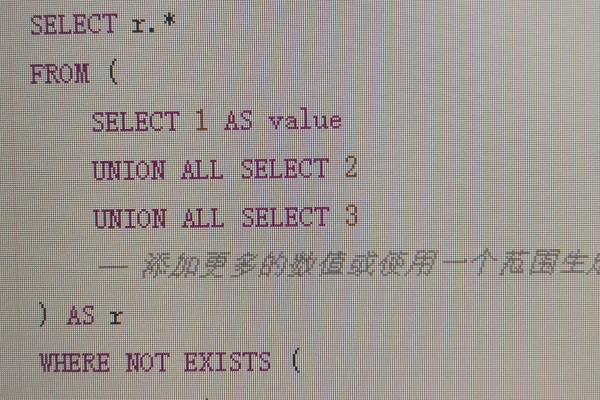C如何判断数据库中的值是否存在?
- 行业动态
- 2025-03-07
- 4
csharp,using System;,using System.Data.SqlClient;public bool CheckValueExists(string connectionString, string query),{, using (SqlConnection connection = new SqlConnection(connectionString)), {, SqlCommand command = new SqlCommand(query, connection);, connection.Open();, object result = command.ExecuteScalar();, return result != null;, },},“这个函数接受数据库连接字符串和SQL查询作为参数,返回一个布尔值表示查询结果是否存在。
在C#中判断数据库值是否存在,通常需要使用ADO.NET或Entity Framework等数据访问技术来连接数据库并执行查询,以下是使用这两种技术的详细步骤和示例代码:
使用ADO.NET判断数据库值是否存在
1、引入命名空间:确保在你的C#项目中引入了必要的命名空间,如System.Data和System.Data.SqlClient(对于SQL Server数据库)。
2、建立数据库连接:使用SqlConnection类创建一个数据库连接对象,并提供连接字符串来指定要连接的数据库服务器、数据库名称、用户名和密码等信息。
3、创建命令对象:使用SqlCommand类创建一个命令对象,并设置其Connection属性为前面创建的连接对象,编写一个SQL查询语句来检查指定的值是否存在于数据库中,这个查询语句通常是一个SELECT语句,它尝试从目标表中选取与指定值匹配的记录。
4、执行查询并处理结果:使用SqlCommand对象的ExecuteReader方法执行查询,并返回一个SqlDataReader对象,通过调用SqlDataReader的Read方法来遍历查询结果,如果Read方法返回true,则表示找到了至少一条匹配的记录,即指定的值存在于数据库中;否则,不存在。

5、关闭连接:无论查询结果如何,最后都需要调用SqlConnection的Close方法来关闭数据库连接,以释放资源。
以下是一个简单的示例代码,演示了如何使用ADO.NET来判断一个名为“username”的值是否存在于名为“Users”的表中:
using System;
using System.Data;
using System.Data.SqlClient;
class Program
{
static void Main()
{
string connectionString = "Server=myServerAddress;Database=myDataBase;User Id=myUsername;Password=myPassword;";
using (SqlConnection connection = new SqlConnection(connectionString))
{
string query = "SELECT COUNT() FROM Users WHERE username = @username";
using (SqlCommand command = new SqlCommand(query, connection))
{
command.Parameters.AddWithValue("@username", "targetUsername");
connection.Open();
object result = command.ExecuteScalar();
if (result != null && (int)result > 0)
{
Console.WriteLine("Value exists in the database.");
}
else
{
Console.WriteLine("Value does not exist in the database.");
}
}
}
}
} 在这个示例中,我们使用了参数化查询来防止SQL注入攻击,并通过ExecuteScalar方法直接获取查询结果的第一行第一列(即记录数),从而判断值是否存在。
使用Entity Framework判断数据库值是否存在

1、配置Entity Framework:确保你的C#项目中已经安装了Entity Framework库,并在App.config或Web.config文件中配置了数据库连接字符串。
2、创建上下文类:使用DbContext类创建一个上下文类,该类表示数据库模型,并包含一个或多个DbSet属性,每个属性对应数据库中的一个表。
3、编写查询表达式:在上下文类中,可以使用LINQ(Language Integrated Query)来编写查询表达式,以检查指定的值是否存在于数据库中,可以使用Any方法来检查集合中是否存在任何满足条件的记录。
4、执行查询并处理结果:执行查询表达式,并根据返回的结果来判断值是否存在,如果查询返回true,则表示值存在;否则,不存在。

以下是一个使用Entity Framework的简单示例,演示了如何判断一个名为“username”的值是否存在于名为“Users”的表中:
using System;
using System.Linq;
using MyDatabaseModel; // 替换为你的实际模型命名空间
class Program
{
static void Main()
{
using (var context = new MyDbContext()) // 替换为你的上下文类名
{
bool exists = context.Users.Any(u => u.username == "targetUsername");
if (exists)
{
Console.WriteLine("Value exists in the database.");
}
else
{
Console.WriteLine("Value does not exist in the database.");
}
}
}
} 在这个示例中,我们首先创建了一个上下文对象,然后使用LINQ的Any方法来检查“Users”表中是否存在任何用户名为“targetUsername”的记录,根据exists变量的值,我们可以判断值是否存在于数据库中。
无论是使用ADO.NET还是Entity Framework,都可以方便地在C#中判断数据库值是否存在,选择哪种技术取决于你的具体需求和项目环境,如果你需要更底层的控制和灵活性,可以选择ADO.NET;如果你更喜欢使用高级抽象和强类型数据集,那么Entity Framework可能是一个更好的选择。







